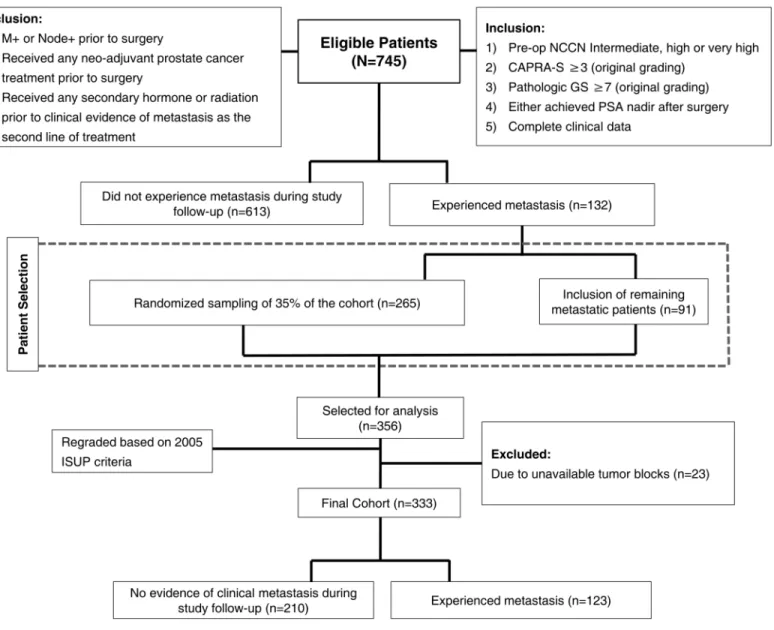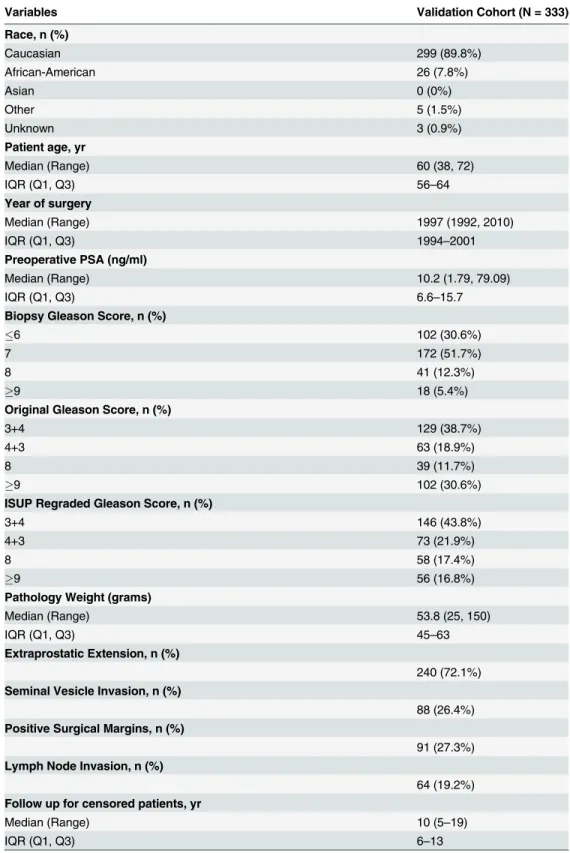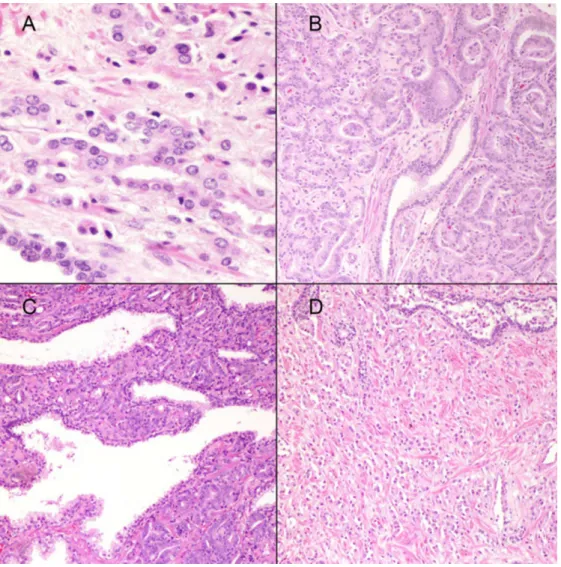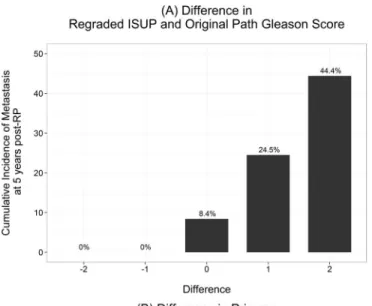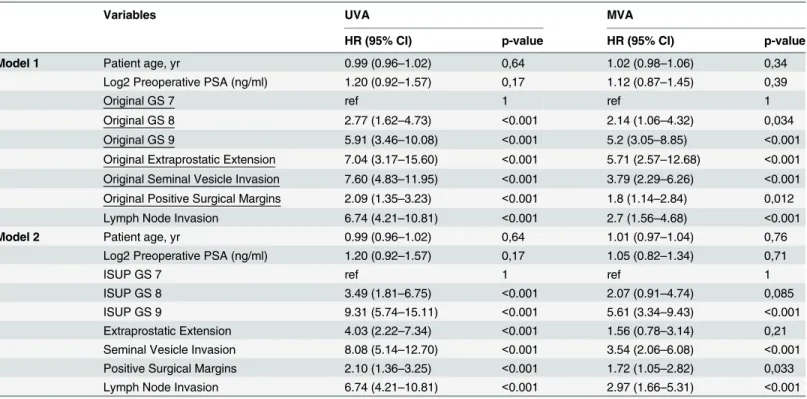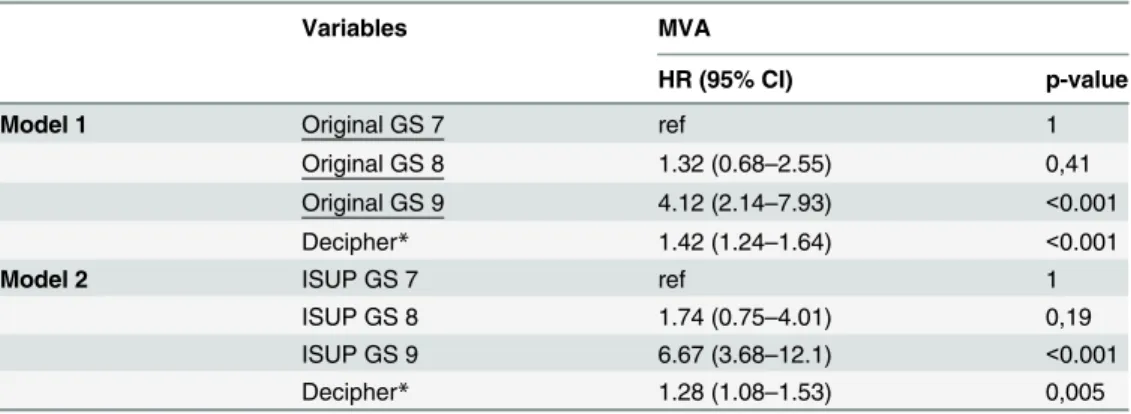Clinical Validation of the 2005 ISUP Gleason
Grading System in a Cohort of Intermediate
and High Risk Men Undergoing Radical
Prostatectomy
Sheila F. Faraj1☯, Stephania M. Bezerra1☯, Kasra Yousefi4, Helen Fedor2,
Stephanie Glavaris2, Misop Han2, Alan W. Partin2, Elizabeth Humphreys2, Jeffrey Tosoian2, Michael H. Johnson2, Elai Davicioni4, Bruce J. Trock2, Edward M. Schaeffer2, Ashley E. Ross1,2,3, George J. Netto1,2,3*
1Department of Pathology, Johns Hopkins Medical Institutions, Baltimore, Maryland, United States of America,2Department of Urology, Johns Hopkins Medical Institutions, Baltimore, Maryland, United States of America,3Department of Oncology, Johns Hopkins Medical Institutions, Baltimore, Maryland, United States of America,4GenomeDx Biosciences, Vancouver, British Columbia, Canada
☯These authors contributed equally to this work. *gnetto1@jhmi.edu
Abstract
In 2005, the International Society of Urological Pathology (ISUP) introduced several modifi-cations to the original Gleason system that were intended to enhance the prognostic power of Gleason score (GS). The objective of this study was to clinically validate the 2005 ISUP Gleason grading system for its ability to detect metastasis. We queried our institutional RP database for men with NCCN clinically localized intermediate to high-risk disease undergo-ing radical prostatectomy (RP) between 1992 and 2010 with no additional treatment until the time of metastatic progression. A case-cohort design was utilized. A total of 333 avail-able RP samples were re-reviewed and GS was reassigned per the 2005 ISUP Gleason system. Cumulative incidence of metastasis was 0%, 8.4%, 24.5% and 44.4% among spec-imens that were downgraded, unchanged, had one point GS increase and two point GS increase, respectively. The hazard ratio for metastasis raised in GS 8 and 9 compared to GS 7 from 2.77 and 5.91 to 3.49 and 9.31, respectively. The survival c-index of GS increased from 0.70 to 0.80 when samples were re-graded at 5 years post RP. The c-index of the reassigned GS was higher than the original GS (0.77 vs 0.64) for predicting PCSM at 10 years post RP. The regraded GS improved the prediction of metastasis and PCSM. This validates the updated Gleason grading system using an unambiguous clinical endpoint and highlights the need for reassignment of Gleason grading according to 2005 ISUP system when considering comparisons of novel biomarkers to clinicopathological variables in archi-val cohorts.
OPEN ACCESS
Citation:Faraj SF, Bezerra SM, Yousefi K, Fedor H,
Glavaris S, Han M, et al. (2016) Clinical Validation of the 2005 ISUP Gleason Grading System in a Cohort of Intermediate and High Risk Men Undergoing Radical Prostatectomy. PLoS ONE 11(1): e0146189. doi:10.1371/journal.pone.0146189
Editor:Xin Gao, Sun Yat-sen University, CHINA
Received:October 18, 2015
Accepted:December 14, 2015
Published:January 5, 2016
Copyright:© 2016 Faraj et al. This is an open
access article distributed under the terms of the Creative Commons Attribution License, which permits unrestricted use, distribution, and reproduction in any medium, provided the original author and source are credited.
Data Availability Statement:All relevant data are
within the paper and its Supporting Information files.
Funding:Kasra Yousefi and Elai Davicione are
Introduction
Recent advances in our understanding of the molecular pathogenesis of prostate cancer have
yielded promising prognostic molecular biomarkers and genomic assays [1–3]. Gleason score
(GS) however remains one of the most powerful predictors of outcome in localized prostate
cancer [4–8] and an essential element of risk stratification schemes [9].
The Gleason grading system was developed by Donald Gleason in 1966 [10] and
subse-quently slightly modified in the 1970s [11]. In 2005, the International Society of Urological
Pathology (ISUP) introduced the first major modifications to the original Gleason system
which was intended to further enhance the prognostic power of GS [5]. Several studies have
established the validity of the 2005 ISUP modified Gleason systems in reaching a superior cor-relation between biopsy and radical prostatectomy (RP) as well as predicting biochemical
recurrence (BCR) and outcome [12–14]. The 2005 ISUP modified GS is the basis for a
pro-posed“Prognostic Grouping Scheme”soon to be adopted by the ISUP [8].
The objective of the current study is to clinically validate the ISUP 2005 Gleason grading system for its ability to predict the occurrence of BCR, metastasis, and prostate cancer specific mortality (PCSM) in a natural history cohort of intermediate and high risk men undergoing RP where all GS and pathologic features were reassigned by a central reviewer.
Materials and Methods
This study was approved by the Institutional Review Board of Johns Hopkins University.
Study Design
Prostate cancer patients treated with RP between 1992 and 2010 were queried from our institu-tional database. This involved identification of all patients who met the following criteria:
pre-operative NCCN intermediate (cT2b-T2c or GS 7 or PSA 10–20 ng/ml), high (cT3a or GS
8–10 or PSA>20ng/ml) and very high (multiple high risk features, primary pattern 5 in any
core, more than 4 cores with GS 8–10, T3b-4) risk disease [15] and had CAPRA-S scores of
3. In order to examine the effect of utilizing the updated ISUP on clinical progression, we
only selected patients who had achieved PSA nadir after surgery defined as PSA<0.2 ng/ml or
had pre-operative imaging confirming local disease only (patients with metastatic disease and positive lymph nodes prior to surgery as well as the ones who received any neoadjuvant treat-ment prior to surgery were excluded). In addition, to examine the utility of the current Gleason grading system we limited our study to a natural history cohort and thus excluded men who received hormone, chemotherapy, or radiation therapy prior to clinical evidence of metastasis. Clinical metastasis was defined as a positive imaging study (i.e. by bone scan, CT scan or MRI). A total of 745 patients met the inclusion/exclusion criteria. A case-cohort design was used to randomly select 35% (n = 265) of the patients from the entire cohort. Following the case-cohort design, 91 non-selected metastatic patients were added to the randomly selected sub-cohort
[16]. Due to lack of available sections and paraffin blocks, 23 patients were excluded from the
356 patients that were initially selected for analysis. A total of 333 men formed the final cohort of the study and grouped as follow: i) men who developed metastasis following RP (n = 123) and ii) men who did not experience clinical evidence of recurrence during study follow-up
(n = 210,Fig 1). All RP slides were reviewed by two expert urologic pathologists (GJN in
con-sensus with SMB or SFF), blinded to patient outcome, for GS reassignment according to 2005
ISUP modified Gleason System [5] and assessment of extraprostatic extension, seminal vesicle
(SV) invasion and surgical margin status. Reviewed 2005 ISUP modified GS was compared to the original GS.
Competing Interests:The authors have declared
Statistical Analysis
Primary endpoint of the study was defined as metastases evidenced by axial imaging or nuclear medicine bone scan. Biochemical recurrence and PCSM were considered as secondary end-points. Upgrading was defined as at least one point rise in GS while downgrading was defined as at least one point decrease in GS.
Cumulative incidence curves for original and re-graded GS were constructed to estimate the risk of metastasis. These curves were obtained after reweighting the controls by inverse of the
sampling fraction as described by Barlow et al [16] to take case-cohort design of the study into
account. Discrimination was measured by concordance index for survival data at 5 years post
RP [17]. Net benefit was estimated using extension of decision curve analysis to survival data at
5 years post RP [18]. Univariable and multivariable Cox proportional-hazards regression was
performed to evaluate the prognostic ability of original and re-graded GS using the“Lin-Ying”
method for the case-cohort design [19]. The significance level was 0.05 for all statistical tests
and analyses were performed in R v3.1 (R Foundation, Vienna, Austria).
Fig 1. Study diagram and patient selection criteria.
Results
Patient demographics and pathologic specimen characteristics are summarized inTable 1.
Selected examples of reassigned GS are depicted inFig 2.
Comparison of original and reviewed radical prostatectomy pathologic
parameters Gleason score
Differences between reassigned ISUP 2005 GS and original GS are graphically illustrated inFig
3. Cumulative incidence of metastasis was 0%, 8.4%, 24.5% and 44.4% among specimens that
were downgraded, unchanged, had one point GS increase and two point GS increase,
respec-tively.Table 2shows that 57 of 333 patients had changes in GS; 37 of which were among the
group who developed metastasis. Most of changes were due to changes in secondary Gleason
pattern (Fig 3B and 3C).
Extraprostatic extension, seminal vesicle invasion and margins status
Table 2summarizes changes in reviewed compared to original variables by oncologic outcome. Surgical margins status was changed in 18 cases, 12 of which in metastatic patients. Extrapro-static extension changed in 15 metaExtrapro-static and 13 non-metaExtrapro-static patients. Changes in SV inva-sion occurred in 7 non-metastatic patients while 3 metastatic changed.
Association of original Gleason Score and reassigned ISUP 2005
Gleason Score with Patient Outcome
Cumulative incidence curves for the development of BCR, metastasis, and PCSM were
strati-fied by original GS as well as re-graded ISUP 2005 GS as shown inFig 4andS1 Fig. As
expected, both original and re-graded ISUP Gleason scores were prognostic of prostate cancer outcomes. ISUP re-grading increased the number of cases classified as GS 9 prostate cancer. These reclassified cases had similar outcomes to GS 9 cancer that was not reclassified (data not shown) and were responsible for a better stratification of oncologic outcomes by Gleason grade.
Univariable and multivariable Cox regression analyses of two models based on original
(model 1) and reviewed pathologic parameters (model 2) are summarized inTable 3. On
uni-variable analysis, the reassigned ISUP 2005 GS better predicted the development of metastasis
post RP. Compared to the reference GS of7, the hazard ratio (HR) for association between
GS 8 and development of metastases increased from 2.77 (95% confidence interval [CI]: 1.62–
4.73) for the original GS to 3.49 (95% CI: 1.81–6.75) when the modified ISUP 2005 GS was
used. The HR for association between GS 9 and metastasis increased from 5.91 (95% CI: 3.46–
10.08) for the original GS to 9.31 (95% CI: 5.74–15.11) for the reassigned ISUP 2005 GS.
Presence of extrapostatic extension, SV invasion and positive surgical margins was also sig-nificantly associated with development of metastases using either original or reviewed parame-ters. On multivariable analysis, GS, presence of SV invasion, positive surgical margin and lymph node metastasis were significantly associated with metastasis in both models. On the other hand, presence of extraprostatic extension was only significant in model 1.
On additional univariable analysis, the HR for association between PCSM and original GS
was 3.96 (95% CI: 1.47–10.66; p = 0.006) and 2.79 (95% CI: 0.75–10.36; p = 0.12) for GS 8 and
GS9 compared to GS 7 as reference, respectively. For association between PCSM and
re-graded GS, the HR was 2.52 (95% CI: -.49–12.98; p = 0.27) and 9.51 (95% CI: 3.33–27.07;
Table 1. Cohort Demographic and Clinical Characteristics.
Variables Validation Cohort (N = 333)
Race, n (%)
Caucasian 299 (89.8%)
African-American 26 (7.8%)
Asian 0 (0%)
Other 5 (1.5%)
Unknown 3 (0.9%)
Patient age, yr
Median (Range) 60 (38, 72)
IQR (Q1, Q3) 56–64
Year of surgery
Median (Range) 1997 (1992, 2010)
IQR (Q1, Q3) 1994–2001
Preoperative PSA (ng/ml)
Median (Range) 10.2 (1.79, 79.09)
IQR (Q1, Q3) 6.6–15.7
Biopsy Gleason Score, n (%)
6 102 (30.6%)
7 172 (51.7%)
8 41 (12.3%)
9 18 (5.4%)
Original Gleason Score, n (%)
3+4 129 (38.7%)
4+3 63 (18.9%)
8 39 (11.7%)
9 102 (30.6%)
ISUP Regraded Gleason Score, n (%)
3+4 146 (43.8%)
4+3 73 (21.9%)
8 58 (17.4%)
9 56 (16.8%)
Pathology Weight (grams)
Median (Range) 53.8 (25, 150)
IQR (Q1, Q3) 45–63
Extraprostatic Extension, n (%)
240 (72.1%) Seminal Vesicle Invasion, n (%)
88 (26.4%) Positive Surgical Margins, n (%)
91 (27.3%) Lymph Node Invasion, n (%)
64 (19.2%) Follow up for censored patients, yr
Median (Range) 10 (5–19)
IQR (Q1, Q3) 6–13
Abbreviations: IQR = interquartile range, mo = months, PSA = prostate specific antigen, RP = radical prostatectomy, yr = year
Survival concordance index and decision curve analysis findings are depicted inFig 5. As
shown inFig 5A, the reassigned ISUP 2015 GS outperformed the original GS in survival
con-cordance index at 5 years post RP (C-index: 0.80 [95% CI: 0.72–0.88] vs 0.70 [95% CI: 0.60–
0.80]). Likewise, the reassigned ISUP 2005 GS showed a superior net benefit on decision curve
analysis at 5 years post RP across a wide range of probability thresholds from ~ 5–30% (Fig
5B). The concordance index of the reassigned GS was higher than the original GS (C-index:
0.77 [95% CI: 0.69–0.92] vs 0.64 [95% CI: 0.56–0.84]) for predicting PCSM at 10 years post RP.
On decision curve analysis on PCSM at 10 years post RP, reassigned ISUP 2005 showed higher
net benefit compared to original GS (S2 Fig).
Finally we explored whether pathologic ISUP re-grading would modulate the utility of molecular tissue testing. 260 cases of the current cohort were previously analyzed by Decipher
[2]. In a multivariable analysis, HRs for metastasis post-RP for Decipher were 1.42 (95% CI:
Fig 2. (A) Fused glands (400x). In the original Gleason grading this pattern was considered pattern 3. According to the 2005 ISUP Gleason system it would be graded as pattern 4; B) Adenocarcinoma with glomeruloid features currently assigned a Gleason pattern 4 (100x); C) Ill-defined glands (100x). This pattern would be graded as Gleason pattern 4 by the ISUP 2005 Gleason grading; and D) Individual cells (100x).This pattern was originally accepted under Gleason pattern 3 and would be assigned a Gleason pattern 5 according to the 2005 ISUP Gleason system.
Fig 3. Cumulative incidence of metastasis at 5 years post radical prostatectomy.A) Difference in re-graded 2005 ISUP modified and original Gleason score; B) Difference in primary re-re-graded 2005 ISUP modified and original Gleason score; and C) Difference in secondary re-graded 2005 ISUP modified and original Gleason score.
1.24–1.64; p<0.001) and 1.28 (95% CI: 1.08-1-53; p = 0.005) when adjusting for original and
re-graded GS, respectively (Table 4).
Discussion
Since its original description, several aspects of the Gleason grading system have changed where morphologic patterns would be interpreted differently in contemporary pathology prac-tice. The most salient modifications were introduced by the 2005 ISUP consensus conference
which led to the adoption of the“2005 ISUP Modified Gleason Grading System”by the
pathol-ogy community [5–8]. In addition to the virtual absence of Gleason patterns 1 and 2 in current
practice, the most prominent changes include the expanded assignment of pattern 4 to almost all cribriform gland patterns as well as fused and poorly formed glands. Individual cells
origi-nally accepted under Gleason pattern 3 would be currently assigned a pattern 5 [5,13]. These
Table 2. Changes in regraded variables compared to original variables by oncologic outcome.
Variables Non-Metastatic* Metastatic All Patients
Change in Gleason Score, n 20 37 57
Change in Primary Gleason Grade, n 13 7 20
Change in Secondary Gleason Grade, n 24 36 60
Change in Surgical Margin Status, n 6 12 18
Change in Extraprostatic Extension, n 13 15 28
Change in Seminal Vesicle Invasion, n 7 3 10
*These patients did not metastasize during study follow-up.
doi:10.1371/journal.pone.0146189.t002
Fig 4. Cumulative incidence curves of A) metastasis by original Gleason score, B) metastasis by reviewed Gleason score.The number at risk in each group is shown in the footnote lines. Patients in the sub-cohort who do not experience the event are weighted by the inverse of the sampling fraction in following the case-cohort design.
Table 3. Univariable and Multivariable Cox proportional hazards analysis of risk factors using original and ISUP regraded GS.
Variables UVA MVA
HR (95% CI) p-value HR (95% CI) p-value
Model 1 Patient age, yr 0.99 (0.96–1.02) 0,64 1.02 (0.98–1.06) 0,34
Log2 Preoperative PSA (ng/ml) 1.20 (0.92–1.57) 0,17 1.12 (0.87–1.45) 0,39
Original GS 7 ref 1 ref 1
Original GS 8 2.77 (1.62–4.73) <0.001 2.14 (1.06–4.32) 0,034
Original GS 9 5.91 (3.46–10.08) <0.001 5.2 (3.05–8.85) <0.001
Original Extraprostatic Extension 7.04 (3.17–15.60) <0.001 5.71 (2.57–12.68) <0.001
Original Seminal Vesicle Invasion 7.60 (4.83–11.95) <0.001 3.79 (2.29–6.26) <0.001
Original Positive Surgical Margins 2.09 (1.35–3.23) <0.001 1.8 (1.14–2.84) 0,012
Lymph Node Invasion 6.74 (4.21–10.81) <0.001 2.7 (1.56–4.68) <0.001
Model 2 Patient age, yr 0.99 (0.96–1.02) 0,64 1.01 (0.97–1.04) 0,76
Log2 Preoperative PSA (ng/ml) 1.20 (0.92–1.57) 0,17 1.05 (0.82–1.34) 0,71
ISUP GS 7 ref 1 ref 1
ISUP GS 8 3.49 (1.81–6.75) <0.001 2.07 (0.91–4.74) 0,085
ISUP GS 9 9.31 (5.74–15.11) <0.001 5.61 (3.34–9.43) <0.001
Extraprostatic Extension 4.03 (2.22–7.34) <0.001 1.56 (0.78–3.14) 0,21
Seminal Vesicle Invasion 8.08 (5.14–12.70) <0.001 3.54 (2.06–6.08) <0.001
Positive Surgical Margins 2.10 (1.36–3.25) <0.001 1.72 (1.05–2.82) 0,033
Lymph Node Invasion 6.74 (4.21–10.81) <0.001 2.97 (1.66–5.31) <0.001
Abbreviations: CI = confidence intervals, HR = hazards ratio, GS = Gleason score, PSA = prostate specific antigen, yr = year
doi:10.1371/journal.pone.0146189.t003
Fig 5. A) Survival concordance index. Reviewed Gleason score by the 2005 ISUP modified Gleason system has the highest c-index compared to original Gleason score. B) Decision curve analysis at 5 years post radical prostatectomy shows the net benefit of original and reviewed Gleason score across probability thresholds.The reviewed Gleason score shows the highest net benefit.
changes in criteria, in addition to the well-recognized interobserver variability in grading among general surgical pathologists compared to pathologist with urologic pathology expertise
[20,21], must be responsible for most of our significant change in GS in the current study. The
change in the overall GS was mainly driven by reassignment of the secondary pattern of
Glea-son grade as shown inTable 2. Our findings further emphasize the need for central pathologic
review of archival specimens by subspecialty experts. The latter is crucial to ensure accuracy and applicability of any biomarker research findings that could be skewed by the great impact of potential GS variations similar to the ones found here. This latter point is highlighted in our finding of the impact of GS ISUP 2005 reassignment in our cohort on the predictive power of a
genomic assay like Decipher (Table 4) where a lower, albeit statistically significant HR for
Deci-pher was found when adjusted for the reassigned GS by expert urologic pathologist compared to original GS.
The 2005 ISUP modified Gleason system has been previously shown to be superior to the
original Gleason system in predicting BCR following prostatectomy [13,14,22,23]. The later
has provided the premise for the recent proposal of assigning a“Prognostic Grade Group”
(Groups I-V) based on ISUP 2005 GS [8,24]. In the current study we aimed to clinically
vali-date the ISUP 2005 modified Gleason grading system ability to predict the occurrence of clini-cally recurrence (metastasis), BCR and PCSM in a cliniclini-cally and pathologiclini-cally well annotated natural history cohort of intermediate and high risk men undergoing RP. Our findings further validate the superiority of the ISUP 2005 GS in predicting metastasis and survival outcomes. We found a superior separation of cumulative metastasis incidence curves among the reas-signed 2005 ISUP GS 4+3 and GS 8 (corresponding to the above mentioned proposed
Prognos-tic Grade Groups III and IV respectively) [Fig 4]. We also found an increased HR for the
association of both GS 8 and GS 9 and incidence of metastases using the reassigned ISUP 2005
GS values compared to original GS (Table 3). The reassigned ISUP 2005 GS outperformed
original GS using survival concordance index at 5 years post RP (0.80 vs. 0.70) and showed a superior net benefit on decision curve analysis across a wide range of probability thresholds
from 5–30% (Fig 5).
On multivariable, extraprostatic extension and GS 8 were only significant in model 1 where all the original variables were used. In model 2, the reviewed data were used for GS,
Table 4. Multivariable Cox proportional hazards analysis of Decipher adjusting for original and ISUP regraded GS.
Variables MVA
HR (95% CI) p-value
Model 1 Original GS 7 ref 1
Original GS 8 1.32 (0.68–2.55) 0,41
Original GS 9 4.12 (2.14–7.93) <0.001
Decipher* 1.42 (1.24–1.64) <0.001
Model 2 ISUP GS 7 ref 1
ISUP GS 8 1.74 (0.75–4.01) 0,19
ISUP GS 9 6.67 (3.68–12.1) <0.001
Decipher* 1.28 (1.08–1.53) 0,005
Abbreviations: CI = confidence intervals, HR = hazards ratio, GS = Gleason score, PSA = prostate specific antigen, yr = year
*Decipher is reported per 0.1 unit increase
extraprostatic extension, SV invasion and surgical margins, which might lead to the drop of significance of GS 8 and extraprostatic extension.
The large size of our well annotated natural history cohort of intermediate and high risk prostate cancer patients and the central review of all specimens pathologic features by urologic pathology experts are perceived strength of our study. The retrospective nature of the study is a limitation. Another weakness of the study is that the original pathologic assessment of some cases was done by general surgical pathologists. It is therefore likely that a comprehensive re-review by urologic pathologists is at least partially responsible for the better association with outcome rather than solely the adherence to the modified ISUP 2005 GS criteria. The lack of original Gleason 6 patients due to the study design can be seen as another limitation.
In summary, we found significant difference between original and reassigned ISUP modi-fied GS in our cohort. Upgrading was more frequently seen among the group of men with pro-gression to metastatic disease in which almost one third of cases were upgraded. The ISUP 2005 modified GS was found to better predict the development of metastasis post RP. Strong consideration should be made for re-grading pathologic tissue when conducting retrospective biomarker studies.
Supporting Information
S1 Fig. Cumulative incidence curves of (A) BCR by original Gleason score, (B) BCR by reviewed Gleason score, C) PCSM by original Gleason score, D) PCSM by reviewed Gleason score.The number at risk in each group is shown in the footnote lines. Patients in the sub-cohort are used.
(TIF)
S2 Fig. A) Survival concordance index for predicting PCSM at 10 years post radical prosta-tectomy. C-index of the reassigned Gleason score was higher than the original Gleason score. B) Decision curve analysis at 10 years post radical prostatectomy.The reassigned ISUP 2005 Gleason score shows a higher net benefit compared to original Gleason score. (TIF)
Acknowledgments
Presented in part in abstract format at the American Urologic Association 2015 annual meet-ing in New Orleans, L.A., USA
Author Contributions
Conceived and designed the experiments: GJN AER ED BJT EMS AWP. Performed the experi-ments: SFF SMB SG HF JT MHJ. Analyzed the data: KY GJN SG ED BJT EH MH. Contributed reagents/materials/analysis tools: GJN EMS AER. Wrote the paper: SFF GJN AER EMS KY.
References
1. Boström PJ, Bjartell AS, Catto JW, Eggener SE, Lilja H, Loeb S, et al. Genomic Predictors of Outcome in Prostate Cancer. Eur Urol. 2015. doi:10.1016/j.eururo.2015.04.008PMID:25913390.
2. Ross AE, Johnson MH, Yousefi K, Davicioni E, Netto GJ, Marchionni L, et al. Tissue-based Genomics Augments Post-prostatectomy Risk Stratification in a Natural History Cohort of Intermediate- and High-Risk Men. Eur Urol. 2015. doi:10.1016/j.eururo.2015.05.042PMID:26058959.
4. Epstein JI, Egevad L, Humphrey PA, Montironi R, Diagnostic II. Best Practices Recommendations in the Application of Immunohistochemistry in the Prostate Report From the International Society of Uro-logic Pathology Consensus Conference. American Journal of Surgical Pathology. 2014; 38(8):E6–E19.
PMID:WOS:000339258600001. doi:10.1097/PAS.0000000000000238
5. Epstein JI, Allsbrook WC, Amin MB, Egevad LL, Comm IG. The 2005 International Society of Urological Pathology (ISUP) Consensus Conference on Gleason Grading of Prostatic Carcinoma. American Jour-nal of Surgical Pathology. 2005; 29(9):1228–42. doi:10.1097/01.pas.0000173646.99337.b1PMID:
WOS:000231513400015.
6. Zareba P, Zhang J, Yilmaz A, Trpkov K. The impact of the 2005 International Society of Urological Pathology (ISUP) consensus on Gleason grading in contemporary practice. Histopathology. 2009; 55 (4):384–91. doi:10.1111/j.1365-2559.2009.03405.xPMID:WOS:000270662500002.
7. Egevad L, Mazzucchelli R, Montironi R. Implications of the International Society of Urological Pathology Modified Gleason Grading System. Archives of Pathology & Laboratory Medicine. 2012; 136(4):426–
34. doi:10.5858/arpa.2011-0495-RAPMID:WOS:000302915700014.
8. Pierorazio PM, Walsh PC, Partin AW, Epstein JI. Prognostic Gleason grade grouping: data based on the modified Gleason scoring system. Bju International. 2013; 111(5):753–60. doi:
10.1111/j.1464-410X.2012.11611.xPMID:WOS:000317865200024.
9. Mohler JL, Kantoff PW, Armstrong AJ, Bahnson RR, Cohen M, D'Amico AV, et al. Prostate Cancer, Version 1.2014 Featured Updates to the NCCN Guidelines. Journal of the National Comprehensive Cancer Network. 2013; 11(12):1471–9. PMID:WOS:000328639000005.
10. Gleason DF. Classification of prostatic carcinomas. Cancer Chemother Rep. 1966; 50(3):125–8. PMID:
5948714.
11. Gleason DF, Mellinger GT. Prediction of prognosis for prostatic adenocarcinoma by combined histolog-ical grading and clinhistolog-ical staging. J Urol. 1974; 111(1):58–64. PMID:4813554.
12. Helpap B, Egevad L. The significance of modified Gleason grading of prostatic carcinoma in biopsy and radical prostatectomy specimens. Virchows Archiv. 2006; 449(6):622–7. doi:
10.1007/s00428-006-0310-6PMID:WOS:000242329600003.
13. Billis A, Guimaraes MS, Freitas LLL, Meirelles L, Magna LA, Ferreira U. The impact of the 2005 Interna-tional Society of Urological Pathology consensus conference on standard Gleason grading of prostatic carcinoma in needle biopsies. Journal of Urology. 2008; 180(2):548–52. doi:10.1016/j.juro.2008.04.
018PMID:WOS:000257589600038.
14. Tsivian M, Sun L, Mouraviev V, Madden JF, Mayes JM, Moul JW, et al. Changes in Gleason Score Grading and Their Effect in Predicting Outcome After Radical Prostatectomy. Urology. 2009; 74 (5):1090–3. doi:10.1016/j.urology.2009.03.043PMID:WOS:000271992400050.
15. Faisal FA, Sundi D, Pierorazio PM, Ball MW, Humphreys EB, Han M, et al. Outcomes of men with an elevated prostate-specific antigen (PSA) level as their sole preoperative intermediate- or high-risk fea-ture. BJU Int. 2014; 114(6b):E120–9. doi:10.1111/bju.12771PMID:24731026; PubMed Central
PMCID: PMCPMC4352319.
16. Barlow WE, Ichikawa L, Rosner D, Izumi S. Analysis of case-cohort designs. Journal of Clinical Epide-miology. 1999; 52(12):1165–72. doi:10.1016/s0895-4356(99)00102-xPMID:
WOS:000083817000006.
17. Heagerty PJ, Lumley T, Pepe MS. Time-dependent ROC curves for censored survival data and a diag-nostic marker. Biometrics. 2000; 56(2):337–44. PMID:10877287.
18. Vickers AJ, Cronin AM, Elkin EB, Gonen M. Extensions to decision curve analysis, a novel method for evaluating diagnostic tests, prediction models and molecular markers. BMC Med Inform Decis Mak. 2008; 8:53. doi:10.1186/1472-6947-8-53PMID:19036144; PubMed Central PMCID:
PMCPMC2611975.
19. Lin DY, Ying Z. COX REGRESSION WITH INCOMPLETE COVARIATE MEASUREMENTS. Journal of the American Statistical Association. 1993; 88(424):1341–9. doi:10.2307/2291275PMID:WOS:
A1993MG97300022.
20. Allsbrook WC, Mangold KA, Johnson MH, Lane RB, Lane CG, Epstein JI. Interobserver reproducibility of Gleason grading of prostatic carcinoma: General pathologists. Human Pathology. 2001; 32(1):81–8.
doi:10.1053/hupa.2001.21135PMID:WOS:000166729700013.
21. Allsbrook WC, Mangold KA, Johnson MH, Lane RB, Lane CG, Amin MB, et al. Interobserver reproduc-ibility of Gleason grading of prostatic carcinoma: Urologic pathologists. Human Pathology. 2001; 32 (1):74–80. doi:10.1053/hupa.2001.21134PMID:WOS:000166729700012.
22. Uemura H, Hoshino K, Sasaki T, Miyoshi Y, Ishiguro H, Inayama Y, et al. Usefulness of the 2005 Inter-national Society of Urologic Pathology Gleason grading system in prostate biopsy and radical prosta-tectomy specimens. Bju International. 2009; 103(9):1190–4. doi:10.1111/j.1464-410X.2008.08197.x
23. Berney DM, Fisher G, Kattan MW, Oliver RTD, Moller H, Fearn P, et al. Major shifts in the treatment and prognosis of prostate cancer due to changes in pathological diagnosis and grading. Bju Interna-tional. 2007; 100(6):1240–4. doi:10.1111/j.1464-410X.2007.07199.xPMID:WOS:000250552700011.
24. Carter HB, Partin AW, Walsh PC, Trock BJ, Veltri RW, Nelson WG, et al. Gleason Score 6 Adenocarci-noma: Should It Be Labeled As Cancer? Journal of Clinical Oncology. 2012; 30(35):4294–6. doi:10.
